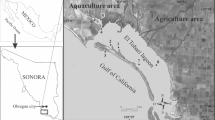Abstract
Rates of lead accumulation from contaminated food sources were examined for the fresh-water gastropods,Physa integra andCampeloma decisum. Lead was slowly accumulated fromaufwuchs (0.52–0.87 Μg Pb/g dry wt of tissue/day) by the grazing snail,P. integra while no statistically significant lead accumulation from sediments was noted in the deposit/suspension feeder,C. decisum. Aufwuchs-associated iron and manganese did not affect the bioavailability of lead.
Similar content being viewed by others
References
Boyden, C. R.: Trace element content and body size in molluscs. Nature251, 311 (1974).
—: Effect of size upon metal content of shellfish. J. Mar. Biol. Assoc. U.K.57, 675 (1977).
Bryan, G. W., and L. G. Hummerstone: Heavy metals in the burrowing bivalve,Scrobicularia plana, from contaminated and uncontaminated estuaries. J. Mar. Biol. Assoc. U.K.58, 401 (1978).
Coughtrey, P. J., and M. H. Martin: The uptake of lead, zinc, cadmium, and copper by the pulmonate,Helix aspersa, and its relevance to monitoring of heavy metal contamination of the environment. Oecologia27, 65 (1977).
EPA,U.S. Environmental Protection Agency: Environmental monitoring series. Quality assurance guidelines for biological testing. Environmental Monitoring and Support Laboratory, Cincinnati, OH. EPA-600/4-78-043, 1978.
Hodson, P. V., B. R. Blunt, and D. J. Spry: Chronic toxicity of waterborne and dietary lead to rainbow trout (Salmo gairdneri) in Lake Ontario water. Water Res.12, 869 (1978).
Luoma, S. N., and G. W. Bryan: Factors controlling the availability of sediment-bound lead to the estuarine bivalve,Scrobicularia plana. J. Mar. Biol. Assoc. U.K.58, 793 (1978).
Newman, M. C.: Environmental and physiological factors contributing to tissue lead concentrations in freshwater molluscs. Doctoral Dissertation. Rutgers University, New Brunswick, NJ (1981).
Newman, M. C., and A. W. McIntosh: The influence of lead in components of a freshwater ecosystem on molluscan tissue lead concentrations. Aquatic Toxicol.2, 1 (1982).
—: Lead elimination and size effects on accumulation by two freshwater gastropods. Arch. Environ. Contam. Toxicol.12, 25 (1983).
Newman, M. C., A. W. McIntosh, and V. A. Greenhut: Geochemical factors complicating the use ofaufwuchs as a biomonitor for lead levels in two New Jersey reservoirs. Water Res.,17, 625 (1983).
Schulz-Baldes, M.: Lead uptake from seawater and food, and lead-loss in the common mussel,Mytilus edulis. Mar. Biol. (Berlin)25, 177 (1974).
Spehar, R. L., R. L. Anderson, and J. T. Friandt: Toxicity and bioaccumulation of cadmium and lead in aquatic invertebrates. Environ. Pollut.15, 195 (1978).
Author information
Authors and Affiliations
Rights and permissions
About this article
Cite this article
Newman, M.C., McIntosh, A.W. Slow accumulation of lead from contaminated food sources by the freshwater gastropods,Physa integra andCampeloma decisum . Arch. Environ. Contam. Toxicol. 12, 685–691 (1983). https://doi.org/10.1007/BF01060752
Received:
Revised:
Issue Date:
DOI: https://doi.org/10.1007/BF01060752




